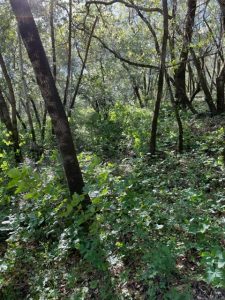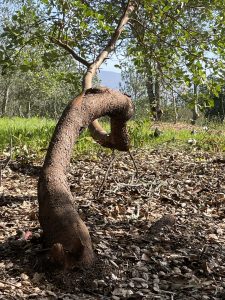My friend Norma says the forest looks like a painting with its lithe, dark trunks of oak and madrone silhouetted against the sunlight. The crew has thinned out young bay laurel and the bushy, tall stands of poison oak and invasive Himalayan blackberries. Yes, I always thought of the forest as verdant, but the over-the-top growth was strangling the oaks and madrone. Besides, the ladder fuels reaching into the treetops and tangled brush below created a fire hazard.
For the first time in the 30 years I have lived here, I can see the undulating contours of the earth itself. Some places are steeper than I imagined; others more gentle and welcoming. Each evening at 4 pm, when the chain saws and chipper stop, I walk the path down the old wagon trail, broadened so equipment could move deeper into the ranch. When I reach the driveway, I follow it back up to the house, marveling at the differences. In places, I can see through the trees far down to the little house on Dry Creek Road where Casey, Melissa, and their sons live. Already I forget what the forest looked like before.
Jesse first questioned the health of the forest twenty years ago when he was a botany major at Humboldt State. He pointed out the overgrowth and the proximity of the many bay to the oaks and madrone, bay being a vector for sudden oak death. The certified forester with Natural Resource Conservation Service (NRCS) agreed, saying we had about 16,000 more bay throughout the ranch than we should.
About the time Jesse drew our attention to this overgrowth, we began to see increased tree death. Before, Donald would scan the forest each spring for a fallen oak, which he would then cut up, split and stack to dry. We would use the wood to heat our house throughout the following winter.
But the numbers of oak and madrone succumbing to oak boar and sudden oak death increased, and we quit burning firewood. Fires make black carbon, a problem in global warming. Add to this the prospect of wildfire. Since 2017, almost 45% of Napa County has burned.
This is when we consulted NRCS. They brought in a certified forester, walked the ranch, made the forest management plan, and awarded a grant to cover up to about 50% of the work. (For more on this, click here and here.)
Forest management is a controversial topic in California. There are various theories about what should or should not be done. Our century-old Smokey, the Bear practice of putting out every fire, has delivered us to the situation we are now in. 24% of California forest land is privately owned. Controversary or not, we must study the best way to manage our forests. It is predicted that all of California will burn. Fire is, after all, indigenous. Maybe we can make it less catastrophic when it does arrive.

Before the thinning and brush clearing.
Yes, the thinning is more drastic than I imagined, but the process renders a beauty I did not expect. I like to think the oaks and madrone will have access to more water and that fewer will die, that this rather extreme measure is good for the forest. This is not clear-cutting a forest for vineyards or other purposes; it is thinning for the health and well-being of the forest.

This madrone grew under thick brush and a coastal live oak, searching for light.
What is also clear is that this is only the beginning. Poison oak and Himalayan blackberries will grow back in force, particularly in these areas now more open to sunlight. Bay trees will re-sprout. It is a sharp learning curve. And it may make all the difference in how the ranch endures drought, wildfire, and floods, these changes brought on by climate disruption.
